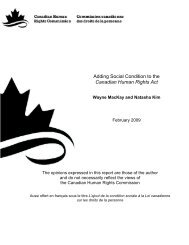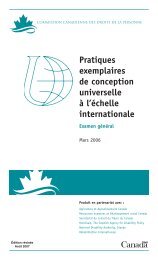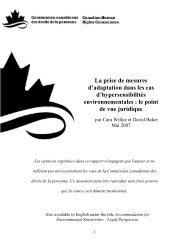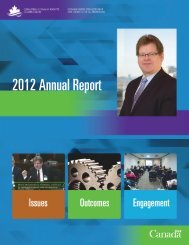Bona Fide Occupational Requirements
Bona Fide Occupational Requirements
Bona Fide Occupational Requirements
- No tags were found...
You also want an ePaper? Increase the reach of your titles
YUMPU automatically turns print PDFs into web optimized ePapers that Google loves.
BONA FIDEOCCUPATIONAL REQUIREMENTSANDBONA FIDE JUSTIFICATIONSUNDER THECANADIAN HUMAN RIGHTS ACTThe Implications of Meiorin and GrismerMarch 2007www.chrc-ccdp.ca
How to reach the Canadian Human Rights CommissionIf you need more information or would like to order other publications, please contact:Commission regional offices in Halifax, Montréal, Toronto, Edmonton and Vancouver, toll free 1-800-999-6899(addresses available on the Commission's website);orNational office at 344 Slater Street, 8th floor, Ottawa, Ontario K1A 1E1Telephone: (613) 995-1151, or toll free 1-888-214-1090TTY: 1-888-643-3304E-mail: info.com@chrc-ccdp.ca | Website: www.chrc-ccdp.caThis document is available on the Commision’s website and on request in alternative formats.© Minister of Public Works and Government Services Canada 2007Cat. No. HR21-53/2007ISBN 978-0-662-49885-8March 2007
TABLE OF CONTENTSPREFACE 1INTRODUCTION 2OVERVIEW OF THE SUPREME COURT OF CANADA DECISIONS IN MEIORIN AND GRISMER 3A. The Meiorin case: British Columbia (Public Service Employee Relations Commission) v. British ColumbiaGovernment and Service Employees' Union 3B. The Grismer case: British Columbia (Superintendent of Motor Vehicles) v. British Columbia(Council of Human Rights) 4IMPLICATIONS FOR THE INVESTIGATION OF COMPLAINTS 5CONCLUSION 6
PREFACESince the Canadian Human Rights Act (CHRA)was first passed in 1977, the law regarding thedefences of bona fide occupational requirement(BFOR) and bona fide justification (BFJ) hasundergone several changes. One of the mostimportant developments occurred in 1999, whenthe Supreme Court of Canada decided two cases 1that have had major legal implications. Theseimplications are most significant for employersand service providers facing complaints of allegeddiscrimination who choose to rely on a BFOR orBFJ defence to justify allegedly discriminatorystandards, policies or practices.These two Supreme Court of Canada decisionsreinforced the duty to accommodate individualswho cannot meet an employment or servicedeliverystandard for any reason related to aground protected by the CHRA, such as disability,sex, family status or religion. They also clarifiedthe nature of the evidence required in cases wherea BFOR or BFJ is raised in defence of a complaintof discrimination.As the Court stated in the first of these decisions:Employers designing workplace standardsowe an obligation to be aware of both thedifferences between individuals, anddifferences that characterize groups ofindividuals. They must build conceptionsof equality into workplace standards. 2The Court expanded on this point in its seconddecision:Employers and others governed by humanrights legislation are now required in allcases to accommodate the characteristics ofaffected groups within their standards,rather than maintaining discriminatorystandards supplemented by accommodationfor those who cannot meet them.Incorporating accommodation into thestandard itself ensures that each person isassessed according to her or his ownpersonal abilities, instead of being judgedagainst presumed group characteristics.Such characteristics are frequently based onbias and historical prejudice and cannotform the basis of reasonably necessarystandards. 3In light of these two decisions, the CanadianHuman Rights Commission integrated the Court'sapproach into its own investigation of complaintsinvolving allegedly discriminatory standards,policies or practices. This document provides anoverview of the decisions and outlines theCommission's current investigation process inthese cases.1 British Columbia (Public Service Employee Relations Commission) v. British Columbia Governmentand Service Employees' Union (B.C.G.S.E.U.), [1999] 3 S.C.R. 3, referred to as the Meiorin case; andBritish Columbia (Superintendent of Motor Vehicles) v. British Columbia (Council of Human Rights),[1999] 3 S.C.R. 868, referred to as the Grismer case.2 Meiorin, supra note 1 at paragraph 68.3 Grismer, supra note 1 at paragraph 19.| 1
INTRODUCTIONIn the past, courts and tribunals approached andanalyzed discrimination cases under human rightslegislation in one of two ways, depending onwhether the discrimination was first characterizedas either "direct" or "indirect" (also known as"adverse effect").Cases of direct discrimination are those where thediscrimination is apparent from the facts. Forexample, a policy that entitles only men to beemployed as security guards would becharacterized as direct discrimination because itexplicitly excludes women. Indirect discrimination,however, is less apparent at first glance. Forexample, a policy that requires job applicants tohave a driver's licence appears neutral, but thisstandard may exclude applicants who are ineligiblefor a licence based on a disability such as epilepsy.Cases such as this one would be characterized asindirect or adverse effect discrimination.Despite the fact that both policies described abovewould negatively affect individuals based on aprohibited ground in the CHRA, the legal analysisapplied to each type of case was significantlydifferent. The defence of a BFOR/BFJ wastraditionally applied only in cases of directdiscrimination.against by any policy or practice. Section 15(2) ofthe Canadian Human Rights Act now states that:For any practice mentioned in paragraph(1)(a) to be considered to be based on abona fide occupational requirement and forany practice mentioned in paragraph (1)(g)to be considered to have a bona fidejustification, it must be established thataccommodation of the needs of anindividual or a class of individuals affectedwould impose undue hardship on the personwho would have to accommodate thoseneeds, considering health, safety and cost.In 1999, the Meiorin and Grismer cases eliminatedany remaining analytical distinction between thedefences for direct and indirect discrimination.The Supreme Court of Canada provided a unifiedtest to be applied consistently to all BFOR/BFJdefences, regardless of whether the discriminationwas direct or indirect.This change simplified the analysis required indiscrimination cases and ensured that, in all caseswhere a BFOR/BFJ is claimed, the employer orservice provider must accommodate individuals tothe point of undue hardship.This historical distinction between the legalanalysis of direct and indirect discrimination wasreduced when amendments to the CanadianHuman Rights Act were passed in June 1998. Thesechanges made it clear that employers and serviceproviders within federal jurisdiction have a duty toaccommodate individuals who are discriminated2 |BONA FIDE OCCUPATIONAL REQUIREMENTS AND BONA FIDE JUSTIFICATIONSUNDER THE CANADIAN HUMAN RIGHTS ACT
OVERVIEW OF THE SUPREME COURTOF CANADA DECISIONS INMEIORIN AND GRISMERA. The Meiorin case: British Columbia (PublicService Employee Relations Commission)v. British Columbia Government and ServiceEmployees' UnionThis case dealt with a grievance by a female forestfirefighter, Tawney Meiorin, who was dismissedfrom her job because she failed one aspect of aminimum fitness standard established by theGovernment of British Columbia for allfirefighters. After Ms. Meiorin had beenperforming the duties of a firefighter for threeyears, the respondent adopted a new series offitness tests, including a running test designed tomeasure aerobic fitness. After failing the test andlosing her job, Ms. Meiorin complained that theaerobic standard discriminated against women incontravention of the British Columbia HumanRights Code, as women generally have loweraerobic capacity, and she had sufficientlydemonstrated she could perform the duties of herjob safely and effectively. The Government ofBritish Columbia argued that this aerobic standardwas a BFOR of the firefighter position.On appeal, the Supreme Court determined thatthe aerobic standard was not a valid BFOR. Inreaching this conclusion, the Court considered thetraditional approach, which analyzed casesdifferently depending on the initial determinationof whether the discrimination was direct oradverse effect. The Court found the differinganalysis in the traditional approach wasinappropriate. It concluded that the distinctionbetween direct and adverse effect discriminationwas artificial, difficult to characterize accuratelyand inconsistent with the purpose of human rightslegislation. The Court also indicated that the oldapproach led to inconsistent outcomes, legitimizedsystemic discrimination, and created a dissonancebetween human rights legislation and the Charterof Rights and Freedoms.The Court therefore rejected the traditionalapproach and established a unified test for BFORdefences to be applied in all cases of direct oradverse effect discrimination. This unified test asksthe following questions:• Is there a standard, policy or practice thatdiscriminates based on a prohibited ground?• Did the employer adopt the standard, policyor practice for a purpose rationally connectedto the performance of the job?• Did the employer adopt the particularstandard, policy or practice in an honest andgood faith belief that it was necessary in orderto fulfill that legitimate work-related purpose?• Is the standard, policy or practice reasonablynecessary in order to fulfill that legitimatework-related purpose?This last element requires the employer to showthat the standard, policy or practice adopted is theleast discriminatory way to achieve the purpose orgoal related to the job at issue. It includes therequirement to demonstrate that it is impossible toaccommodate individual employees withoutimposing undue hardship on the employer.| 3
B. The Grismer case: British Columbia(Superintendent of Motor Vehicles) v.British Columbia (Council of Human Rights)Some three months after the Meiorin decision, theCourt gave its decision in Grismer, a case in whichthe respondent raised a BFJ defence. TerryGrismer, who passed away before the Court heardhis case, had a condition known as homonymoushemianopia (HH), which eliminated his left-sideperipheral vision in both eyes. The BritishColumbia Superintendent of Motor Vehiclescancelled his driver's licence on the ground thathis vision no longer met the standard of aminimum field of vision of 120 degrees. Whilecertain other exceptions to the 120-degreestandard were allowed, people with HH werenever granted a licence.In adapting the Meiorin employment-related testto the BFJ defence in Grismer, the Courtestablished the following questions to ask inservice-related cases:• Is the underlying purpose of the standard,policy or practice rationally connected to theservice provider's function?• Did the service provider adopt the particularstandard in an honest and good faith beliefthat it was necessary in order to fulfill theservice provider's purpose or goal?• Is the standard, policy or practice reasonablynecessary in order to fulfill the serviceprovider's purpose or goal?Mr. Grismer re-applied several times, passing all ofthe requisite tests except the field of vision test,and he was not permitted to demonstrate that hewas able to compensate for his limited field ofvision. He therefore filed a complaint with theBritish Columbia Council of Human Rights. Hewas successful at tribunal on the basis that theSuperintendent had failed to prove that there wasa BFJ for the rigid standard applied to people withHH.On appeal, the Supreme Court of Canada made itclear that the unified test set out in Meiorin wasequally applicable to service provision cases. Usingthe unified approach, the Court concluded thatthe 120-degree vision standard was not reasonablynecessary and struck down the standard because itfailed the final element of the test.4 |BONA FIDE OCCUPATIONAL REQUIREMENTS AND BONA FIDE JUSTIFICATIONSUNDER THE CANADIAN HUMAN RIGHTS ACT
IMPLICATIONS FOR THEINVESTIGATION OF COMPLAINTSAs a result of these two decisions, the Commissionintegrated the unified test into its process forinvestigating complaints where a BFOR/BFJdefence is raised. The following approach appliesto all such complaints within the jurisdiction ofthe Commission, regardless of whether the initialdiscrimination is characterized as direct or adverseeffect.First, an investigation will consider whether thestandard, policy or practice has the direct orindirect effect of excluding or negatively affectingindividuals based on a prohibited ground includedin the CHRA: this is the initial determination ofwhether a prima facie case exists. In theinvestigation, the onus of demonstrating sufficientevidence of the prima facie case lies with thecomplainant.Once a prima facie case is established, the onus ofproving a BFOR/BFJ defence then shifts to therespondent. The investigation will apply theunified test to consider whether there is evidencedemonstrating that the standard, policy or practiceis rationally connected to the work or service, wasmade in good faith and is reasonably necessary. Tosuccessfully defend its standard, policy or practice,the respondent must provide sufficient evidence ofeach of the elements of the unified test.• What is the standard, policy or practice inquestion?• What distinction or exclusion does it makeor imply?• How is this distinction or exclusion directlyor indirectly related to a prohibited groundin the CHRA?If the prima facie case is sufficiently demonstratedby the evidence, the investigation will proceed tostep 2.2. Can the respondent show that the underlyingpurpose of the standard is rationally connectedto the performance of the job or service atissue? Investigation questions to explore thisevidentiary requirement may include thefollowing:• What is the purpose of the challengedstandard, policy or practice?• What are the objective requirements of thejob, or function of the service, at issue(the specific jobs or duties to which thestandard applies)?• How is the purpose related to the objectiverequirements of the job or function of theservice?Specifically, the investigation will assess thefollowing issues in a case.1. Can the complainant show that the policy,standard or practice creates a distinction orexclusion related to one of the prohibitedgrounds in the CHRA? Investigation questionsto explore this evidentiary requirement mayinclude the following:| 5
3. Can the respondent show that the standardwas adopted in an honest and good faith beliefthat it was necessary in order to accomplishthe respondent's purpose? Investigationquestions to explore this evidentiaryrequirement may include the following:• When, how and why was the standarddeveloped?4. Can the respondent show that the standard isreasonably necessary for the employer orservice provider to accomplish its purpose?Investigation questions to explore thisevidentiary requirement may include thefollowing:• Does the standard exclude members of aparticular group based on impressionisticassumptions?• Does the standard treat some to whom itapplies more harshly than others?• Were alternative standards considered, orwere alternatives to the standard itself–suchas individualized testing–considered?• How was the standard designed to minimizethe burden on those required to comply?• What efforts were made to accommodatenegatively affected individuals?• Was the assistance of others sought infinding possible accommodations?• Would the respondent face undue hardshipif it adopted alternative standards orprovided individual accommodation?CONCLUSIONThe Meiorin and Grismer decisions havesignificantly influenced the way the Commissionanalyzes BFORs in employment and BFJs in theprovision of services. This summary of thedecisions is intended to help employers and serviceproviders to develop and implement nondiscriminatorystandards and practices.• If so, why weren't the alternativesimplemented and why was this particularstandard chosen instead of others?• Is the standard the least discriminatorymeans of accomplishing the purpose?• Is it necessary that all employees meet asingle standard, or could varying standardsbe adopted?6 |BONA FIDE OCCUPATIONAL REQUIREMENTS AND BONA FIDE JUSTIFICATIONSUNDER THE CANADIAN HUMAN RIGHTS ACT






